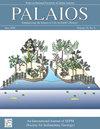异足指数:方枘圆凿?
IF 1.5
4区 地球科学
Q2 GEOLOGY
引用次数: 0
摘要
摘要:异足指数(Heteropody Index, HI)是一种用于计算化石足迹种类和手迹之间面积差异的工具。HI使用简单的长×宽计算来估计面积。然而,由于大多数足印很少接近正方形,使用不同面积计算的HI可能更准确地反映手足和脚足面积的差异。在这项研究中,长度×宽度(L×W)作为基本形状和动物足迹的面积估计的准确性,与另外两个面积计算进行了测试,圆的面积πr2和长度×腕宽(L×CW)(脚与地面接触的最近点的宽度)。此外,利用这些方法计算HI的准确性与使用相应形状的实际面积或脚底面积计算HI的准确性进行了测试。人们发现,除了有蹄类动物外,在大多数动物中,L×W是比πr2更好的面积估计值。然而,对于那些L×W比πr2更好估计的动物来说,L×CW更准确。本文还提出,通过将这些测试的结果与Strickson等人(2019)的结果相结合,可以使用L×CW更准确地估计恐龙的足部面积,以返回接近软组织估计的面积。先前的HI测量可能高估了蜥脚类恐龙的极端异足性。本文章由计算机程序翻译,如有差异,请以英文原文为准。
HETEROPODY INDEX: A SQUARE PEG IN A ROUND HOLE?
Abstract: Heteropody Index (HI) is a tool used to calculate area differences between the manus and pes of fossil trackways. HI uses a simple length × width calculation to estimate area. However, since most foot impressions are rarely close to square in shape, HI using a different area calculation could potentially more accurately reflect differences in manus and pes foot area. In this study, accuracy of length × width (L×W) as an area estimate for basic shapes and animal footprints, was tested against two other area calculations, the area of a circle: πr2, and length × carpal width (L×CW) (the width at the most proximal point of the foot in contact with the ground). In addition, accuracy of HI calculations using these methods was tested against HI calculations using actual area of the corresponding shape or underfoot area. It was discovered that in general L×W is a better estimate for area than πr2, in most animals except ungulates. However, for those animals where L×W was a better estimate than πr2, L×CW was more accurate. This paper additionally proposes that by combining the findings of these tests with those of Strickson et al. (2019), foot area estimates for dinosaurs can be estimated more accurately using L×CW, to return an area close to estimates for soft tissue. Previous HI measurements may have overestimated extreme heteropody in sauropod dinosaurs.
求助全文
通过发布文献求助,成功后即可免费获取论文全文。
去求助
来源期刊

Palaios
地学-地质学
CiteScore
2.80
自引率
12.50%
发文量
40
审稿时长
6 months
期刊介绍:
PALAIOS is a monthly journal, founded in 1986, dedicated to emphasizing the impact of life on Earth''s history as recorded in the paleontological and sedimentological records. PALAIOS disseminates information to an international spectrum of geologists and biologists interested in a broad range of topics, including, but not limited to, biogeochemistry, ichnology, paleoclimatology, paleoecology, paleoceanography, sedimentology, stratigraphy, geomicrobiology, paleobiogeochemistry, and astrobiology.
PALAIOS publishes original papers that emphasize using paleontology to answer important geological and biological questions that further our understanding of Earth history. Accordingly, manuscripts whose subject matter and conclusions have broader geologic implications are much more likely to be selected for publication. Given that the purpose of PALAIOS is to generate enthusiasm for paleontology among a broad spectrum of readers, the editors request the following: titles that generate immediate interest; abstracts that emphasize important conclusions; illustrations of professional caliber used in place of words; and lively, yet scholarly, text.
 求助内容:
求助内容: 应助结果提醒方式:
应助结果提醒方式:


